Brief Introduction of Chinese Dragon
The Chinese Dragon is a Chinese mythical creature that have many animal-like forms such as fish, crocodile, and horse, but is most commonly depicted as snake-like with four legs.Traditionally, the Chinese Dragon symbolizes potent and auspicious powers and is the good fortune bringer that controls rain and water in agricultural society of China. 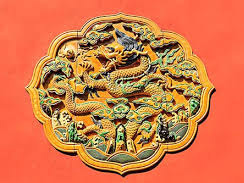 The Chinese feudal emperors adopted the image of dragon as the symbol of imperial power and fashioned their clothes with all kinds of dragon patterns. In Chinese culture, the outstanding people are also compared to a dragon and people have many idioms regarding dragon which are all good wishes, like “hoping one’s sone will become a dragon (望子成龙)”, and “prosperity brought by the dragon and the phoenix (龙凤呈祥)”. In modern China, the Chinese dragon has been transformed from the divine creature to mascot, symbolizing soaring, inspiration, pioneering, and change.
The Chinese feudal emperors adopted the image of dragon as the symbol of imperial power and fashioned their clothes with all kinds of dragon patterns. In Chinese culture, the outstanding people are also compared to a dragon and people have many idioms regarding dragon which are all good wishes, like “hoping one’s sone will become a dragon (望子成龙)”, and “prosperity brought by the dragon and the phoenix (龙凤呈祥)”. In modern China, the Chinese dragon has been transformed from the divine creature to mascot, symbolizing soaring, inspiration, pioneering, and change.
Origin of Chinese Dragon
The Chinese dragon has existed for at least 6000 years. In ancient times, people often made a revered animal, plant, or powerful natural phenomenon as a mark of their clan. They worshiped it and prayed for its protection. The dragon has long been a totem idol in China.
What animals did the dragon originate from? There is no consensus, but different people have varied opinions. 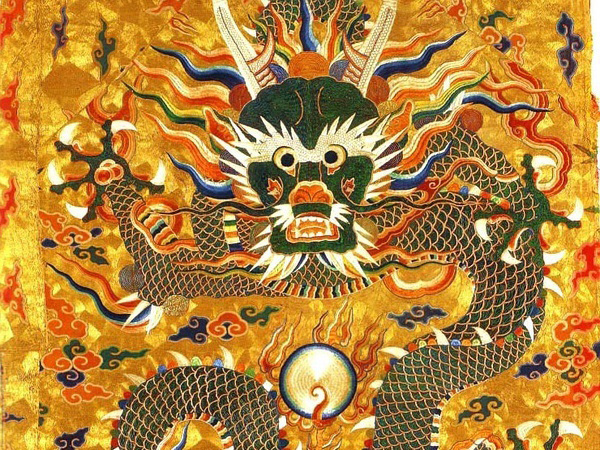 Most experts believe the dragon is a snake-based totem that combined the snake's body, pig's head, the deer's antler, ox's ears, goat's beard, eagle's claw, and fish's scale. This idea makes sense in history. In the ancient clan society, when the Huaxia tribe in the Yellow River basin with the snake as its totem defeated other clans, it made alliances with other clans. By accepting other totems, a new dragon totem is formed.
Most experts believe the dragon is a snake-based totem that combined the snake's body, pig's head, the deer's antler, ox's ears, goat's beard, eagle's claw, and fish's scale. This idea makes sense in history. In the ancient clan society, when the Huaxia tribe in the Yellow River basin with the snake as its totem defeated other clans, it made alliances with other clans. By accepting other totems, a new dragon totem is formed.
In 1987, in Ziyang, Henan province, a dragon made of mussel shells was unearthed in a colossal tomb from Yangshao culture dating back to 6000 years ago. It’s the earliest dragon ever discovered in China, and people regard it as the “First Dragon in China." Meanwhile, a delicate pig-head-shaped jade dragon with a history of over 5000 years was also unearthed in Inner Mongolia, showing the long history of dragon totem in China. Dragon patterns were also commonly used in the bronze vessels and bone artifacts of the Shang and Zhou Dynasties. More than 100 kinds of Chinese characters “龙” were found in the inscription on oracle bones. In the Warring Period, the dragon images were often painted on silk. By the Han Dynasty, the dragon looked similar to the dragon we use today. The dragon's image didn’t change much in later dynasties, but its cultural connotations have been changed.
Cultural Connotations of Dragon
The Chinese dragon has two kinds of cultural connotations; one presents the royal family, and the other is the common understandings of the animal.
Imperial Dragon
The imperial dragon is often hypocritical, deceptive, and intimidating. 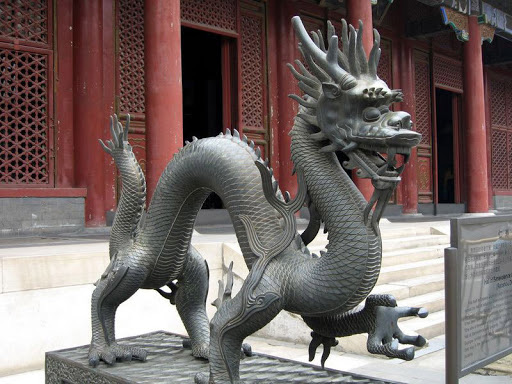 To intimate people spiritually and strengthen their superior ruling power, the feudal emperors advocated the idea of “divine rights of kings” and embodied themselves as the sons of heaven. They couldn’t create the actual images of sons of heaven, so they embezzled dragon images to represent themselves. Dragon thus became the symbol of the emperor. The emperors’ face is called the dragon’s face, their chair the dragon’s chair, their chariot the dragon’s chariot, their costumes their dragon’s robes, their heirs the dragon’s heirs, and their walking the dragon’s walking. Through such a complete series of beautification, the emperors firmly believe that they are the incarnation of the dragon and everyone else should submit allegiance to them. The imperial dragon culture has no value except in the aspects of royal architecture and clothing embroidery.
To intimate people spiritually and strengthen their superior ruling power, the feudal emperors advocated the idea of “divine rights of kings” and embodied themselves as the sons of heaven. They couldn’t create the actual images of sons of heaven, so they embezzled dragon images to represent themselves. Dragon thus became the symbol of the emperor. The emperors’ face is called the dragon’s face, their chair the dragon’s chair, their chariot the dragon’s chariot, their costumes their dragon’s robes, their heirs the dragon’s heirs, and their walking the dragon’s walking. Through such a complete series of beautification, the emperors firmly believe that they are the incarnation of the dragon and everyone else should submit allegiance to them. The imperial dragon culture has no value except in the aspects of royal architecture and clothing embroidery.
Folk Dragon
The folk dragon is sincere, kind, and wise. It’s the actual dragon of the Chinese nationality and represents the primary spiritual character and ideal pursuit of ordinary Chinese people.
1.Justice
The folk dragon represents justice. Chinese people believe that the evil people will be punished sooner or later by the lightning strike (the sound and the action of such a punishment is said from the dragon).
2.Fortune Bringer
In agriculture, rain is extremely important. People used to offer sacrifice to the dragon for rainfall in case of drought days. Chinese people believe that the dragon king will bring water to them once he heard their plea.
3.Strength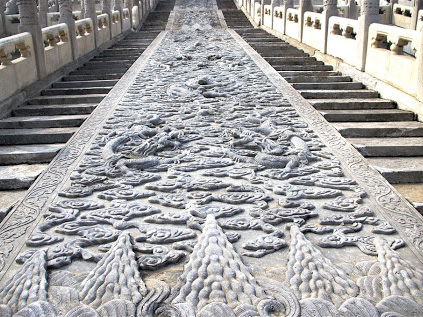
Dragon is considered very strong and powerful. Traditional Chinese people liked such physical appearance.
4.Law
The Chinese people have always respected the law. The first hexagram in I-ching is all about dragon. Everything from “do not move until the right time comes” to “even dragons make mistakes at the highest point” to “there will be no risk when no one fight for the leader” are all showing the law of development by using the dragon’s seasonal activity. People believe that it’s always best to follow the rule of development.
5.Prosperity
From the traditional Chinese people’s perspective, the first and foremost prosperity is more heirs. More sons and daughters mean more wealth. Ancient Chinese people believe that dragon had nine sons as nine is the highest single number. However, such a belief made China’s population go out of control.
Nine Sons of Chinese Dragon
1.Qiuniu (囚牛) - It’s the eldest son of the dragon and fond of music. The legend has it that it often crouch on beside the musical instrument and listen to the melody. Some Huqins still have Qiuniu’s image as decorations on their heads.
2.Yazi (睚眦) - It’s the second son of the dragon and very keen to fight and kill. Many weapons grips have Yazi’s image as decorations.
3.Chaofeng (嘲风) - It’s adventurous and often fashioned as a roof beast to keep the room owner safe.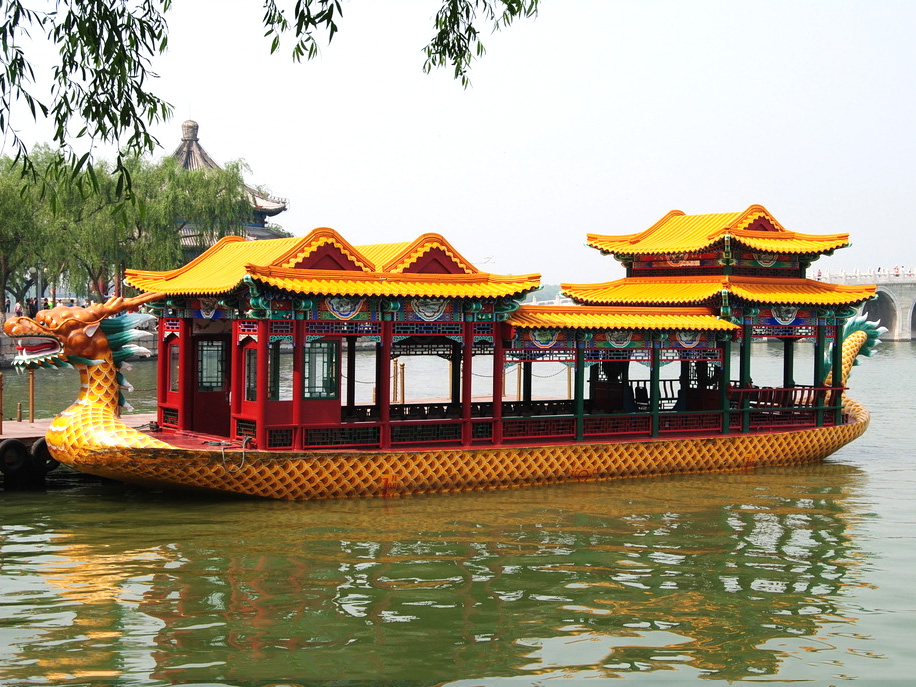
4.Pulao (蒲牢) - It’s known for crying and being noisy. Its’ images are often found in the bells.
5.Suanni (狻猊) - It’s a lot like a lion and fond of quietness and incense smell. Its images are mostly found on the feet of the Buddha seats and censers.
6.Baxia (霸下) - It’s turtle-shaped and very fond of carrying things around. It’s said that Dayu subdued Baxia to help him to maintain the flood of the Yellow River. To avoid any damage the strong Baxia may cause, Dayu gave Baxia a huge stone stele with its achievement of flood control inscribed and ask it to carry. The stele was so massive that even Daxia can’t move one step. Therefore, Baxia’s images are often inscribed in the foundations of some famous steles.
7.Be’an(狴犴) - It’s tiger-shaped and likes lawsuits. The legend has it that the Be’an was always ready to stand out for justice. Thus, its images are mostly found on the doors of the prisons.
8.Fuxi(负屃) - It’s like the typical dragon and likes literature. Most Fuxi images are found alongside the tablet inscriptions.
9.Chiwen (螭吻) - It’s a dragon-like beast that likes to devour things. People use its sculptures to wrap up the palace ridgepole ends.
Chinese Dragons Decorations on Architecture
Before the Han Dynasty, dragon decorations were not exclusive to emperors.  The aristocracies could also use dragon decorations. After the Han Dynasty, the dragon gradually became the symbol of emperors, and the dragon fashions were only allowed for imperials. In Ming and Qing Dynasties, the dragon became the significant decorations in royal palaces. This is why most of the dragon decorations are found in courts. It’s rare to see them in the houses of ordinary people.
The aristocracies could also use dragon decorations. After the Han Dynasty, the dragon gradually became the symbol of emperors, and the dragon fashions were only allowed for imperials. In Ming and Qing Dynasties, the dragon became the significant decorations in royal palaces. This is why most of the dragon decorations are found in courts. It’s rare to see them in the houses of ordinary people.
Take the Forbidden City as an example; there are 1,142 dragon heads on the three-tier foundations of the three biggest palaces. Inside the Hall of Superior Harmony, there is a golden dragon decorated chair. Behind the chair are screens adorned with seven golden dragons. Above, there is a golden-dragon decorated sunk panel, and surrounding it are six dragon pillars.
Dragon Embroidery on Costumes
As mentioned before, the dragon was not exclusive to imperial families before the Han Dynasty. 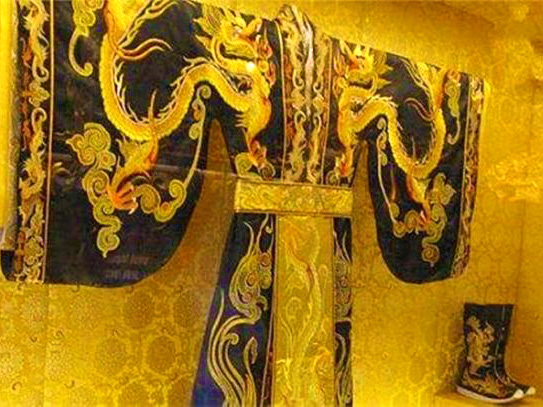 Even if the kings in Western Zhou Dynasty did wear clothes with dragon embroidery, it’s because such a pattern is one of the Twelve Costume designs. Both the kings and ministers could wear such costumes. In the Qin and Han Dynasty, the emperors often wear black clothes, and the dragon decorations were still not commonly used. Since the middle Tang Dynasty, emperors began to wear yellow robes. In the Yuan Dynasty, the dragon patterned clothes became exclusive to the ruling class.
Even if the kings in Western Zhou Dynasty did wear clothes with dragon embroidery, it’s because such a pattern is one of the Twelve Costume designs. Both the kings and ministers could wear such costumes. In the Qin and Han Dynasty, the emperors often wear black clothes, and the dragon decorations were still not commonly used. Since the middle Tang Dynasty, emperors began to wear yellow robes. In the Yuan Dynasty, the dragon patterned clothes became exclusive to the ruling class.
Meanwhile, it was regulated that the dragon patterns with two horns and five claws were only used on emperors’ clothes, while other permitted people could use three or four clawed dragon patterns. In the Ming Dynasty, the dragon patterns were only allowed on yellow robes that the emperors wear. Anyone else was forbidden to use any dragon pattern. However, in the Qing Dynasty, ministers could also wear dragon decorated costumes in any color but yellow.
The dragon is one of the 12 animal zodiacs in China that ranks in fifth place. The recent dragon years are 1904, 1916, 1928, 1940, 1952, 1964, 1976, 1988, 2000, 2012, and 2014. As many Chinese political leaders are dragons, Chinese people deem dragons years the right time to have children. The dragon people are unrelenting, self-centered, even a bit arrogant. They have strong confidence and high self-esteem, which makes it hard to get along with others. However, the dragons are generally lucky, making them more likely to succeed.
Dragons Related Festivals and Celebrations
Dragon-Head-Raising Festival
The Dragon-Head-Raising Festival is a traditional Han nationality holiday on lunar February 2nd. It’s said that the dragons that control rain and water will wake up and raise their head, meaning the spring rain will come soon. Modern Chinese don’t celebrate this festival, but in some Shaanxi, Gansu, and Shandong areas, particular food is still prepared for the day.
Dragon-boat Festival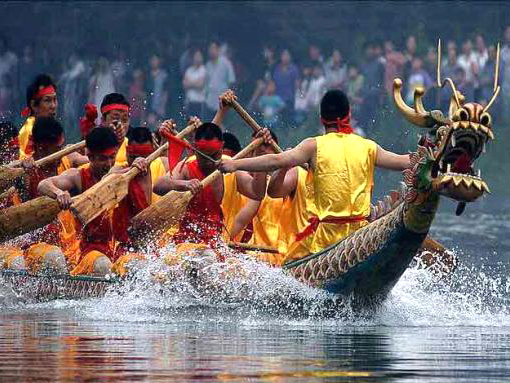
The Dragon-boat Festival is about the great poet and politician Qu Yuan, but people usually organize the dragon-boat racing to memorize him.
Dragon Head Festival
It is a festival exclusive to the Yao Nationality in Yunnan. The Yao people often offer sacrifice on lunar Jan.5 to dragon kings.
Dragon Fair
The Dragon Fair is one of the traditional festivals in the Naxi nationality of Lijiang, Yunnan. On lunar Mar.15, the local people will go to the dragon fair to enjoy horse racing, opera shows, local exhibitions, and other activities.
Dragon Lantern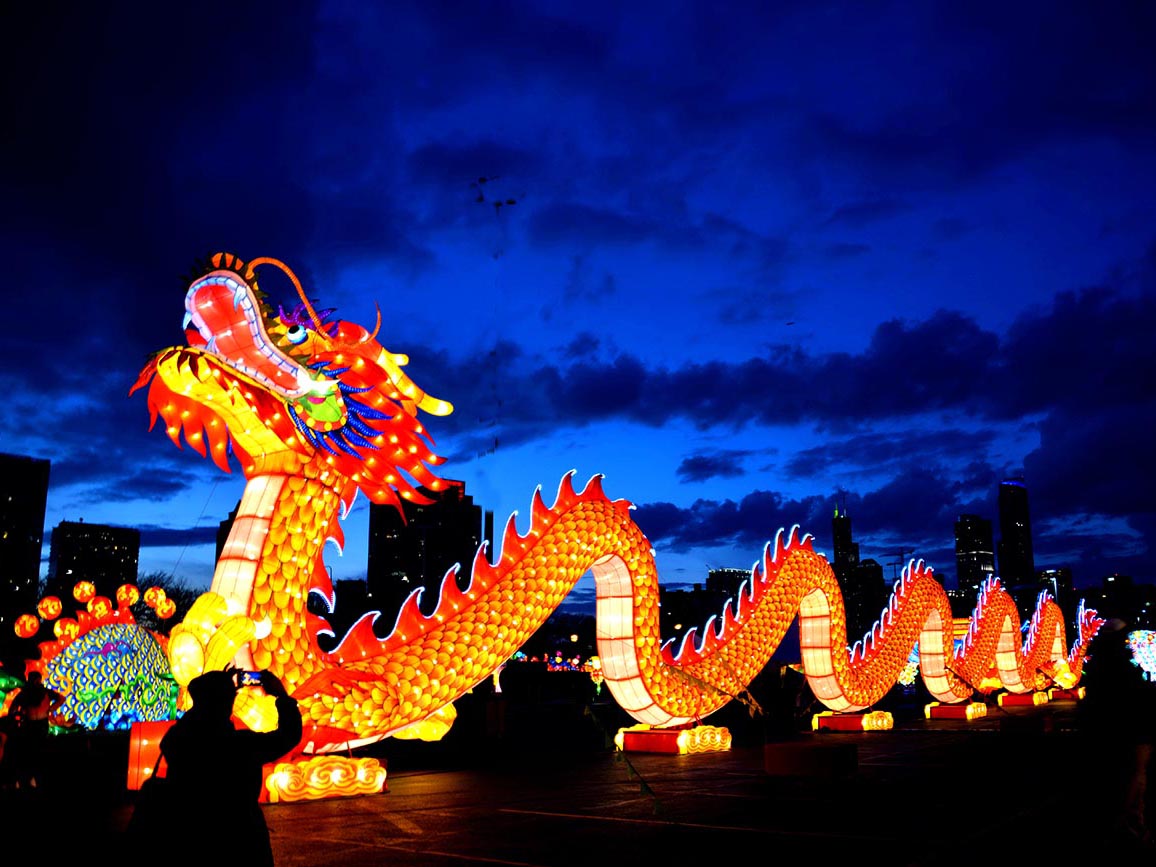
Dragon lantern is not a festival, but a show performed in many big festivals, especially in the Lantern Festival. People use paper, bamboo, wood, and fabric to make long dragons spanning 70 meters. A dozen people will be employed to hold the long dragon and perform the dragon dance.
What is the difference between Chinese Dragon and Western Dragon?
Dragons are not only found in China but also in the myths of western countries. However, the Chinese dragon is quite different from the western dragon.
Similarity: Both Chinese and western dragons have four legs, sharp claws, and horns. They both can fly.
Difference:
1.Chinese dragon only has one head, while western dragon may have 3, 9, or even 12 heads.
2.Chinese dragon sprays water while the western dragon spits fire.
3.Chinese dragon represents auspiciousness; while the western dragon represents evil.
There is no right or wrong about both dragons; each represents a different culture.
7 Commonly Used Idioms Associated with Dragon
攀龙附凤(attaching to the dragon and phoenix): fawn upon the influential people
画龙点睛(adding eyes to a dragon): bring out the crucial point.
卧虎藏龙(crouching tiger, hidden dragon): undiscovered talents.
降龙伏虎(subdue the dragon and tame the tiger): overcome the powerful adversaries.
龙飞凤舞(flying dragons and dancing phoenixes): lively and vigorous in calligraphy.
龙马精神(the vigor of a dragon or horse): the vibrant spirit of the aged.
鱼龙混杂(fish and dragons are mixed up): the good and evil people are mixed up.
Related Articles
Chinese Phoenix
23 Unique Chinese Lucky Symbols
Year of the Dragon
 The Chinese feudal emperors adopted the image of dragon as the symbol of imperial power and fashioned their clothes with all kinds of dragon patterns. In Chinese culture, the outstanding people are also compared to a dragon and people have many idioms regarding dragon which are all good wishes, like “hoping one’s sone will become a dragon (望子成龙)”, and “prosperity brought by the dragon and the phoenix (龙凤呈祥)”. In modern China, the Chinese dragon has been transformed from the divine creature to mascot, symbolizing soaring, inspiration, pioneering, and change.
The Chinese feudal emperors adopted the image of dragon as the symbol of imperial power and fashioned their clothes with all kinds of dragon patterns. In Chinese culture, the outstanding people are also compared to a dragon and people have many idioms regarding dragon which are all good wishes, like “hoping one’s sone will become a dragon (望子成龙)”, and “prosperity brought by the dragon and the phoenix (龙凤呈祥)”. In modern China, the Chinese dragon has been transformed from the divine creature to mascot, symbolizing soaring, inspiration, pioneering, and change.
 Most experts believe the dragon is a snake-based totem that combined the snake's body, pig's head, the deer's antler, ox's ears, goat's beard, eagle's claw, and fish's scale. This idea makes sense in history. In the ancient clan society, when the Huaxia tribe in the Yellow River basin with the snake as its totem defeated other clans, it made alliances with other clans. By accepting other totems, a new dragon totem is formed.
Most experts believe the dragon is a snake-based totem that combined the snake's body, pig's head, the deer's antler, ox's ears, goat's beard, eagle's claw, and fish's scale. This idea makes sense in history. In the ancient clan society, when the Huaxia tribe in the Yellow River basin with the snake as its totem defeated other clans, it made alliances with other clans. By accepting other totems, a new dragon totem is formed. To intimate people spiritually and strengthen their superior ruling power, the feudal emperors advocated the idea of “divine rights of kings” and embodied themselves as the sons of heaven. They couldn’t create the actual images of sons of heaven, so they embezzled dragon images to represent themselves. Dragon thus became the symbol of the emperor. The emperors’ face is called the dragon’s face, their chair the dragon’s chair, their chariot the dragon’s chariot, their costumes their dragon’s robes, their heirs the dragon’s heirs, and their walking the dragon’s walking. Through such a complete series of beautification, the emperors firmly believe that they are the incarnation of the dragon and everyone else should submit allegiance to them. The imperial dragon culture has no value except in the aspects of royal architecture and clothing embroidery.
To intimate people spiritually and strengthen their superior ruling power, the feudal emperors advocated the idea of “divine rights of kings” and embodied themselves as the sons of heaven. They couldn’t create the actual images of sons of heaven, so they embezzled dragon images to represent themselves. Dragon thus became the symbol of the emperor. The emperors’ face is called the dragon’s face, their chair the dragon’s chair, their chariot the dragon’s chariot, their costumes their dragon’s robes, their heirs the dragon’s heirs, and their walking the dragon’s walking. Through such a complete series of beautification, the emperors firmly believe that they are the incarnation of the dragon and everyone else should submit allegiance to them. The imperial dragon culture has no value except in the aspects of royal architecture and clothing embroidery.

 The aristocracies could also use dragon decorations. After the Han Dynasty, the dragon gradually became the symbol of emperors, and the dragon fashions were only allowed for imperials. In Ming and Qing Dynasties, the dragon became the significant decorations in royal palaces. This is why most of the dragon decorations are found in courts. It’s rare to see them in the houses of ordinary people.
The aristocracies could also use dragon decorations. After the Han Dynasty, the dragon gradually became the symbol of emperors, and the dragon fashions were only allowed for imperials. In Ming and Qing Dynasties, the dragon became the significant decorations in royal palaces. This is why most of the dragon decorations are found in courts. It’s rare to see them in the houses of ordinary people.  Even if the kings in Western Zhou Dynasty did wear clothes with dragon embroidery, it’s because such a pattern is one of the Twelve Costume designs. Both the kings and ministers could wear such costumes. In the Qin and Han Dynasty, the emperors often wear black clothes, and the dragon decorations were still not commonly used. Since the middle Tang Dynasty, emperors began to wear yellow robes. In the Yuan Dynasty, the dragon patterned clothes became exclusive to the ruling class.
Even if the kings in Western Zhou Dynasty did wear clothes with dragon embroidery, it’s because such a pattern is one of the Twelve Costume designs. Both the kings and ministers could wear such costumes. In the Qin and Han Dynasty, the emperors often wear black clothes, and the dragon decorations were still not commonly used. Since the middle Tang Dynasty, emperors began to wear yellow robes. In the Yuan Dynasty, the dragon patterned clothes became exclusive to the ruling class.


